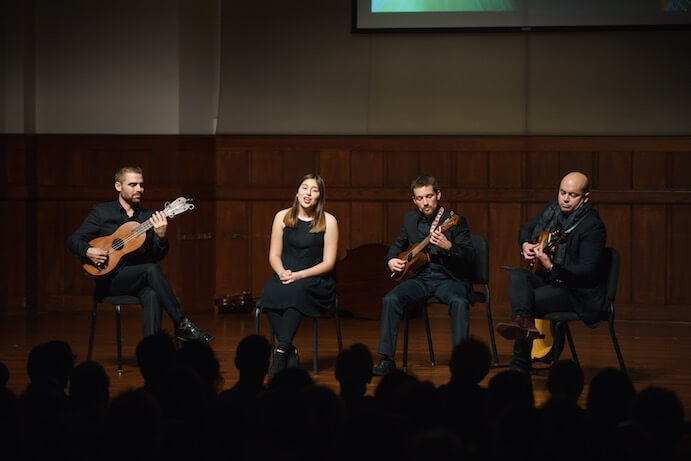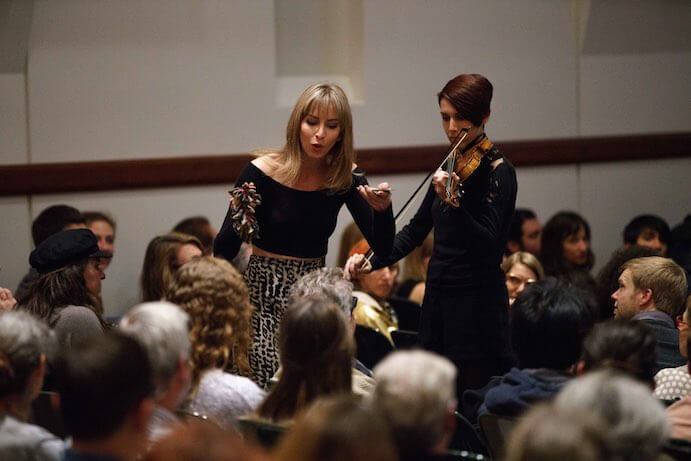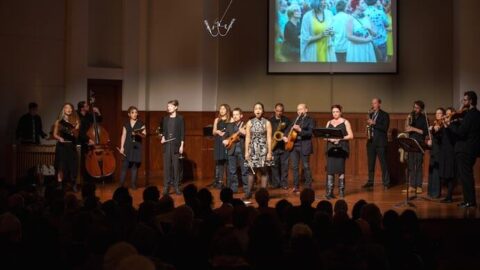The University of Southern California’s Arts and Humanities Initiative—Visions and Voices—planned to (re)stage The Industry’s grandiloquent multi-media multi-author opera Hopscotch. If you are unfamiliar with this work, understand it was a high-stakes gamble of a staging concept put forth into execution through a dizzying array of municipal and non-profit organization partnerships, and widely-acclaimed in the national and international press. What was the gamble? To infuse Los Angeles into the form with “driving” as the vector. Specifically, to stage the multi-composer story on multiple routes and in multiple vehicles. This Markov Chain of narrative displacement, spectator atomization, and velocopedic urbanity splintered the opera into three separate routes, making it difficult to view the complete work, which is why USC’s decision to stage Hopscotch (in redacted form) was appealing. Except that, this concert almost didn’t happen.
It dawned on Mr. Sharon that the concert’s date was going to overlap with the bitter inauguration of reality-TV blatherskite Donald J. Trump as the 45th President of The United States, who the day before had announced terrible cuts to The National Endowment For The Arts and The National Endowment For The Humanities. For Sharon, frustrated relenting would have given way to a cancellation had it not been for Sasha Anawalt, the USC Visions & Voices co-organizer, who implored Sharon to go forward with the concert. This turnaround was recounted by Mr. Sharon himself, from the podium within the Alfred Newman Recital Hall. The timing of this ominous interstice was not lost to those in attendance, many of whom–performers, composers, academics, critics, patrons (collectively: ensembles, organizations, academic institutions, non-profits)–depend on a healthy cultural sector. Sharon continued … “This occasion demands of all of us, regardless of whatever political party you ascribe to … to consider very solemnly and very seriously, what we pledge our allegiance to.” Hopscotch is a cooperative work of a large and diverse group, after all, and as such it points a way forward.

It began with music for Mexican string ensemble, Lucha’s Quinceañera Song, by David Rosenboom, with text by Janine Salinas Schoenberg. This celebration of the Quinceañera (15th year birthday) featured striking modulations and very latinate, romantic gestures. Punctuated by pockets of silences as young Lucha, affectionately performed by Natasha Sanchez, confronts her own transformation using a mixture of English and Spanish, and holding out her refrain “Porque ahora soy mujer (Because now I am a woman)” as the starting declamation of her life’s layered journey. Jumping ahead several chapters was Andrew McIntosh‘s Never The End, with text by Sarah Beaty. A vocal duo comprised of Lauren Davis (now playing Lucha) and Sarah Beaty, and a solo saxophonist accompanying their solemn refrains, intertwined their sounds together. As they built large reservoirs of microtonality, more saxophone players joined-in and dispersed throughout the hall, adding some nice antiphonal theatricality.
Following was Veronika Krausas‘ Is All Time Simultaneous? with text by Tom Jacobson. In this piece, the audience was directly confronted, and to some they were dealt cards, by a fortune teller, played by Julia Aks alongside her solo violin accompaniment provided by Madeline Falcone. Cards for “The Angels,” “The Ghost,” and “The Puppet” were received. Tonal, yet tempered by pointed dissonance, the scene shifted suddenly as Justine Aronson entered from Stage Right to fill the center of the space with just a small wind-up music box in hand; her beautiful range echoing the ramifications of the “uncertainty principle” of the text.

In Lucha and Orpheo by Marc Lowenstein (who is also Musical Director for The Industry), meta-operatic questions are posed (“An Aria? A Recitative?”) and in the middle section, after a driving phase-shift motive in the violin duo subsides, we reach a kind of hopeful music (that Sharon advocates for) that then ends with a bolero singer singing in Spanish: “Esa vida, mejor que se acabe. No es para mi (It is better that this life ends. It is not for me).” In Ellen Reid‘s Farewell From The Rooftops, with text by poet Mandy Kahn, an ensemble of mixed strings and brass continued in exploiting the hall’s various spaces to antiphonal effect. “A future life that never came to be” sung against Melinda Rice’s viola pizzicato and interjected by Jonah Levy’s muted trumpet shrieks and swells from the horns. “I feel my powers now”—as the movement draws to a close with a vocal and french horn duet.
Most striking was the evening’s finale: Andrew Norman and Jane Stephens Rosenthal’s To Find The Center, which fulfilled the ambition of inscribing an image of unity into our glimpse of this (un)charted territory; diatonic and interleaving consonances and resonances growing as every performer that evening reconvened and slowly joined each other on the stage, every singer/instrumentalist (which was which at this point?) until all were together, sound filling the space, lifting the collective into the heavens of acousmatic sensuality but of hopeful spiritus everlasting. A mass of bodies, making sound together; all voices ending on a unison.
HOPSCOTCH After-Movie from The Industry on Vimeo.
In a way, the ellipse formed from Hopscotch turning in onto itself in order to reveal its most revealed musical gestalt (one which necessitated such widespread berth and tangible circumnavigability when it—literally—took to the streets), by containing it into a space that Sharon may retroactively view (in the positive) as a non-space (the traditional concert hall), amplified its communicative means. What The Industry’s flagship flirtation with democratic-artmaking on the eve of Donald Trump’s calls to end what he called “American Carnage,” gave re-defined meaning to what Philosopher of Speed Paul Virilio called “disorienting pleasures,” by allowing the negative feedback of the closed space itself to serve as the antithesis to the dwindling narrative of a narrow worldview, one which was wholly and gloriously disassembled both in the concert hall that evening and in the hours of the day that followed during the largest demonstration in US history, the 2017 Women’s March. All of this leads us instead towards a future polity where things are public; where art is public; where a new res publica emerges.
























